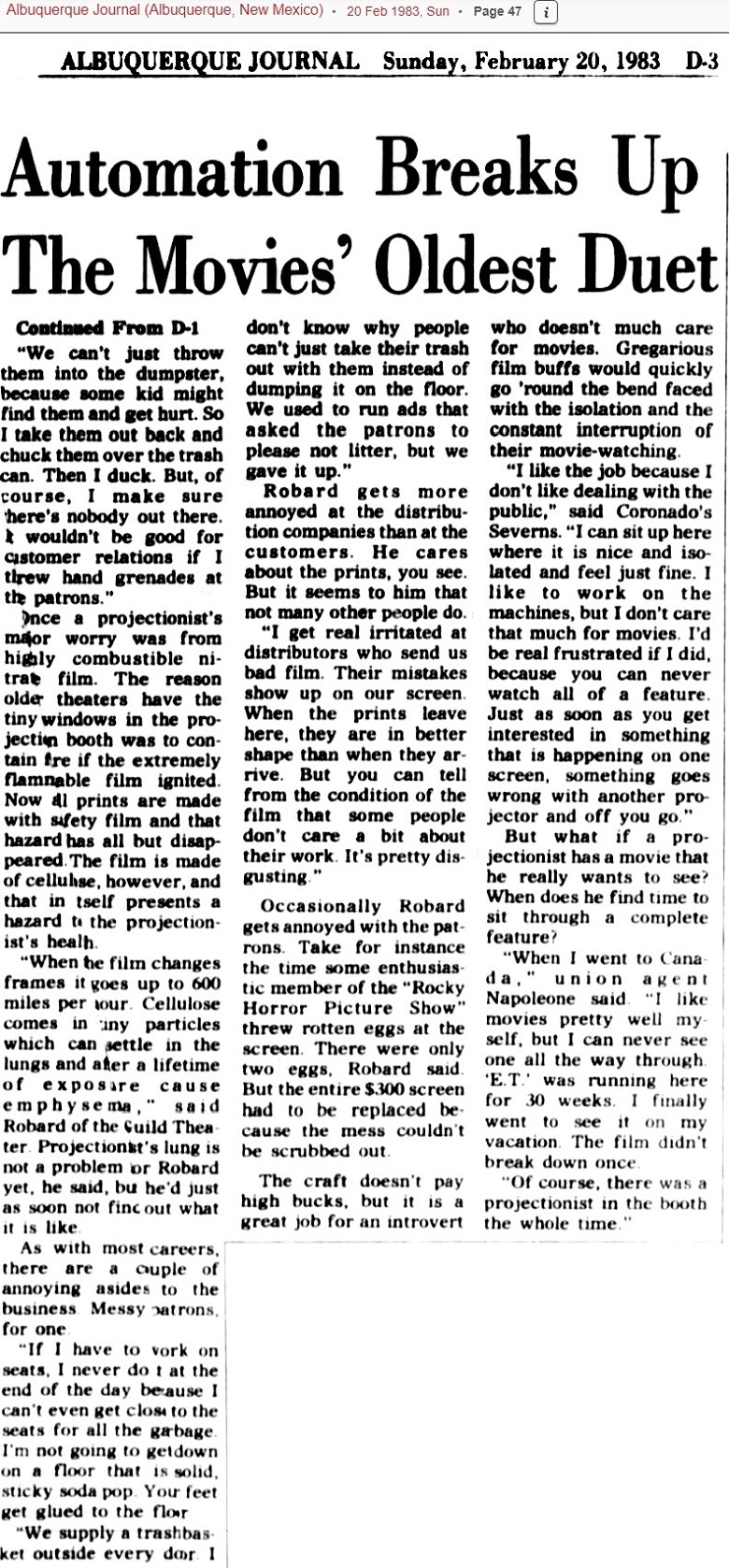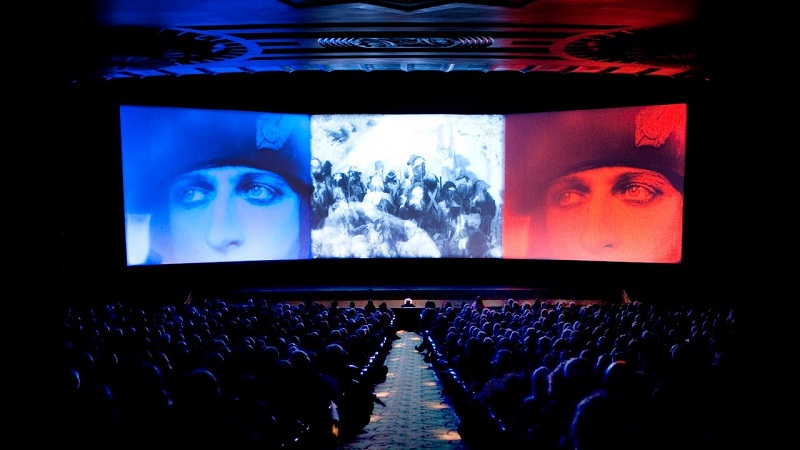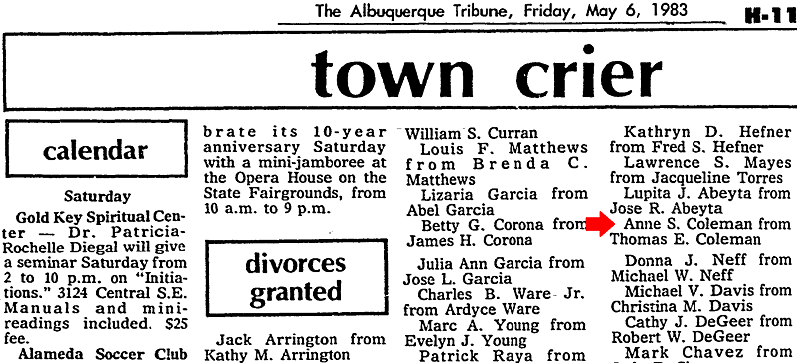Chapter 30
Let Bygones Be Bygones
Let Bygones Be Bygones
My memory:
In the autumn of 1980, I was walking south on Louisiana Boulevard, west side of the street,
and when I got a little past Indian School Road, a bicyclist stopped to chat with he, and he was beaming.
He was Ernie, who said how happy he was to see me.
I was totally confused, and entirely suspicious.
I did not want to see him, and I made no secret of that.
He looked hurt and asked why I was upset.
As if he didn’t know.
I gave him a for-instance: I was shortchanged $25.81 by payroll.
He promised to get the money to me.
He also said that, really honest and for-true, he was truly glad to see me again,
and he further said that if there were any movies I wanted to see,
all I had to do was to phone him and he would arrange to have me walked in, for free.
I did not believe him, but I tried my luck and said that I wanted to see
Caligula, which was soon scheduled to open.
Done deal.
He would walk me in on the first Saturday showing, and I could bring along a friend.
A few days later, a thick envelope
arrived in the mail, with Ernie’s return address,
and inside, in cash, was $25.81.
Well, it appears that the evidence is lying to me.
But that’s impossible.
No, it is my memory that has been lying to me, and it has been lying to me for a long, long time.
I just found my documents in storage.
Our sidewalk encounter was not in the autumn of 1980, but in August 1979.
I made no mention of Caligula, since it had not yet been released.
The $25.81 in cash arrived in the mail in September 1979.
I just read that letter again, for the first time since 1979.
Ernie was really trying to be sweet, and he signed it, “Your friend.”
Sigh. I should have made a bit more of an effort, I see now, but my trust had been ripped away from me.
If I had to do it all over again, I would be much more open.
At the time, though, with my life experiences, I was never open to the idea of being open.
As far as I was concerned, Ernie had refused me a key to the building,
it was clear that he had wanted me gone from about the time I started,
and I strongly suspected that he had been a party to the vandalization parties.
Besides, when he fired me, he made sure to make it sting, and he was explicit that I was not welcome back.
Why should I trust this guy?
Well, as the decades have tramped onwards, I see that I should have given him a chance.
Here is my guess, and I shall never know if my guess has any truth to it at all:
My guess is that, after I got the boot, Mark boasted to Ernie that he should get credit for that,
since he had sabotaged my work so that I would get kicked to the curb, much to the entire staff’s blessed relief.
My guess is that Ernie felt horrible about that and wanted to make it up to me somehow.
My guess, of course, is total fantasy, but it may well be what had happened.
I’ll never know.
So why is my memory telling me that our brief meeting on the sidewalk was a year later,
and that during that brief sidewalk meeting, he agreed to allow me to see Caligula?
There is one, and only one, possibility:
I ignored his offer for a year, until I learned that Caligula would soon open at Donald Pancho’s.
Surely I phoned him at work and asked if he would let me in, and surely he agreed.
I combined the two memories into one, and I got it wrong.
Like I say five times every week: If I ever get called to testify in court, I would be charged with perjury,
precisely for the reason that my memory plays such egregious tricks on me.
Okay. The payment was cash, and so it was not payroll that made this up to me.
It was the guy himself, out of his own pocket.
Okay. I took him up on his offer.
He agreed to let a friend and me in to Caligula.
On Saturday, 4 October 1980, he met us at the door and walked us in for free.
He invited me up to the booth to chat for a few moments before the show, and he pointed out something odd.
He couldn’t understand why all the leaders and tails said MY SON MY SON instead of CALIGULA.
I explained that to him as best I could.
He also told me that they had scheduled a press screening, but that Penthouse phoned up and told them to cancel it.
Yes, I explained that Penthouse did not want press screenings or press passes.
He also guessed, correctly, that I had seen him quoted about projection.
He was a tiny bit nervous.
“What I said was basically right, wasn’t it?” he asked, a bit hesitantly.
I held my tongue, and said, “Yeah, it was basically right.”
Actually, he had made a howler when chatting with the journalist.
He said that the exciter bulb pulses 20,000 times each second to produce the sound.
Say what?
The exciter bulb is incandescent DC, steady on.
The pulsation, which never reaches 20,000Hz, is created by the optical soundtrack that passes between the exciter bulb and the pickup.
He knew electricity and electronics and he could make basic repairs.
How could he have thought such a thing?
Oh well. Let it go. Let it go. Let it go.
Don’t stir up trouble.
“Yeah, it was basically right.”
That howler made me wonder, though; it made me wonder many things.
|
Oh, that interview he gave. Yes.
When doing research to scribble this web page, I ran across that interview repeatedly.
Every time I typed in “Don Pancho’s” and/or “projectionist,”
it popped up again.
Now I can’t find it because of a computer crash at Newspapers.com.
The searchable index for several years’ worth of the Albuquerque Journal disappeared.
With luck, in the next few months that index will build itself up again anew.
In the meantime, as I scroll through the pages, nearly every last one has an error message at the top:

That means that the pages need to be OCR-scanned. Yet again.
Until that message goes away, those pages are no longer searchable.
Zo, until I can locate that article again, this is what I can recall.
I cannot remember which journalist penned that article,
but I do remember it concerned automation and the impending end of the age of the projectionist.
Not only was Ernie interviewed, there was a photo of him loading a 2,000' reel onto projector # 2.
So when I said above that I had never found a photo of any part of the interior of Don Pancho’s, I was wrong.
I had forgotten about that other photo.
I desperately need to find it.
He told about how the films arrived in a shambles
and that Don Pancho’s generally shipped them back out in better condition than when they were received.
He also spoke about planning for the future, taking courses in surveying at TVI
so that he could have a new job lined up once his current one became obsolete.
Rudy was interviewed as well, as he both praised and condemned the automation.
Another person I knew was interviewed, and he spoke about working only parttime while untrained teens took over his duties for large parts of the week.
He was now given new duties, such as repairing seats and fixing the plumbing.
My memory (which is wrong) is that the article began right at the bottom of
So much for my memory indeed!
I found it!
I guess the search engines and the OCR have mended themselves.
Besides, I kept searching on Ernie’s real name, which kept getting me nowhere, because his real name does not appear in this article.
His surname was misprinted throughout.
We did NOT talk about this article on Saturday afternoon, the 4th of October 1980. Nope.
We talked about this article two and a half years later!
How on earth did I misremember that?
Good heavens!
I have no explanation.
He was not as wrong about 20,000Hz as I had misremembered.
At least he said that it is the squiggly line that created the oscillation.
Still, though, not 20,000Hz. Never 20,000Hz. Never.
Zo, we talked about this, only for the briefest moment, when he walked me in to see Chilly Scenes of Winter on Saturday afternoon, 26 March 1983.
Oy vey.
The picture in the paper does not show Ernie at projector # 2; it shows him at projector # 1.
What other things have I misremembered throughout the decades?
If this case were in court, and if, under oath, I had stated my recollections as given above,
and if the opponent’s lawyer’s secretary were to have found the article below,
I would have lost my case and I would have been fined or even jailed, and my credibility would have been destroyed forever.
I thought my memory was better than this. Really, I did.
The journalist was
K.C. Compton
and the photographer was Brian Walski.
Maybe I should drop them a note?
Anyway, here is the article in all its glory.
|
A manager was up in the booth with him, and they both agreed that Caligula was really getting them down.
The manager was not someone I had met before.
The two of them were pondering if this was the worst movie they had ever run.
After a moment, the manager asked Ernie if “Solo” was worse?
(He meant Salò.)
Oh yes, agreed Ernie, “Solo” was definitely worse.
I mentioned another movie I was interested in seeing,
Figures in a Landscape,
also with Malcolm McDowell, and asked if there were any plans to book it on their repertory schedule.
Ernie’s response: “We’re all tired of Malcolm McDowell.”
I also pointed out, not to gripe, but to be helpful, that the star’s name was misspelled on the marquee:
“MALCOMB MCDOWEL.”
I was a bit nervous to mention that, because that’s the sort of thing that would have gotten me a tongue-lashing when I was an employee.
“Pushy! Pushy! Pushy! How can anyone be so pushy?!?!?!!!”
This time, though, no problems.
The manager took note.
Also, during that conversation of only a few minutes,
Ernie mentioned that the owner had recently hired a company technician
to ensure that all the cinemas in the Movie, Inc., chain were properly set up and maintained.
The first thing that this technician asked was which apertures Don Pancho’s and The Guild were using.
When he heard the list of widescreen formats, he asked about Academy 1:1.375.
Nope, said Ernie, we don’t do that here.
Well, said the technician, we need to set you up for that.
Now, when I had attended and then worked at Donald Pancho’s,
one of the reasons everyone was so exasperated with me, sick and tired of me,
furious with me, was because I kept insisting that we needed to be set up for Academy 1:1.375
as well as for the MovieTone and Silent formats.
I did not like cropping those films,
and I thought it was unfair to paying audiences to deprive them of significant portions of the movies they had purchased tickets for.
Nobody wanted to hear that.
Everybody thought I was just complaining, they thought I was being
“Pushy! Pushy! Pushy! How can anyone be so pushy?!?!?!!!”
They couldn’t endure my blathering and wished I would just shut up already.
So, after they gave me the boot, they hired a professional who said essentially the same thing, and he got laudits.
Go figure.
I responded to Ernie and the manager that it was good to have Academy, at long last, but what about MovieTone and Silent?
The cinemas needed those too.
They just looked confused.
Ernie certainly knew about those two formats. He had frequently run across them, I explained them to him in years past,
and I had even posted a typed memo about them above the inspection bench back in early 1977.
He had read it. He had understood it.
Why did he now look confused?
Nonetheless, they never set up for Academy 1:1.375.
Nothing changed.
Maybe they fired the technician, too?
Maybe they found him too pushy?
I don’t know.
While I was in the booth for those few minutes, my friend downstairs noticed something.
A group of guys was walking down the sidewalk and stopped to look at the Caligula poster in the display window.
They read down the list of credits, and then one of them shouted out,
“Principal Photography by Tinto Brass?
Oh god no. We don’t want to see that!!!”
They all agreed and walked away.
Now, no Tinto Brass movie had ever been shown in Albuquerque, at any cinema or on television
(or, I should say, on the extremely unlikely chance that one of his movies had been shown, it had not been advertised —
sometimes I wonder if one of those endless announcements of “TITLE TOO HOT TO PRINT” was actually the brilliant
Nerosubianco,
which, in the US, was sickeningly and falsely retitled The Artful Penetration of Barbara).
Tinto was completely unknown in Albuquerque.
Who were those guys, and how did they know the name Tinto Brass?
I stepped in to the Gents’ for a moment, and was disappointed to see
that the ads that had once covered the walls were all removed.
Caligula was a rotten movie, but with breathtaking visuals.
The film had been taken away from Tinto and violently altered.
The result hardly bears any resemblance to what Tinto had filmed.
The story was changed, the dialogue was changed, the comedy (there was gobs of comedy) was entirely deleted,
the music was changed, the sound effects were changed, and the whole point to the tale was changed.
What was left on screen was only ruins of what had once been a movie.
Tinto was never allowed to assemble his version, and he never will be.
(Fortunately, in about 2013, Tinto told my friend Alex Tuschinski, at great length,
in vivid detail, point by point, step by step, what he had wanted with the movie.
Alex would theoretically be able to reconstruct Tinto’s intentions.
Penthouse considered hiring him to perform such a task, but then decided against the idea.
Anyway, it seems that much of the master materials were destroyed recently.
So much for that.)
Nonetheless, I was glad to see that rotten movie, but I was uncomfortable to be back in that building.
When my friend and I walked out of the show two and a half hours later, we saw that the star’s name was now correctly spelled on the marquee.
It was not that day, but a few weeks later,
that an assistant manager (whom I had never met before) granted my request to borrow the press kit, so that I could make a photocopy,
and I gave him a date and time when I promised to return it.
When that date and time arrived, I found that it was impossible to make my way down to the cinema,
and so I phoned and asked to have him put on the line.
He answered the phone in a cheery tone of voice, and I apologized, saying I would have to return the press kit a day or two late.
Silence. Stone-cold smoldering silence.
Why had I wasted his time with such useless information?
Just return it whenever you can! he said sharply as he hung up the phone.
That outburst of friendliness-turned-to-outraged-anger exemplified the collective personality of the place,
the personality that (save Mark Brown and Mrs. A) all management and staff shared.
It was a personality that I could never understand.
When I returned the press kit, this assistant manager was glad to get it back, and glad to see me.
Again, I did not — and still do not — understand these waves of unmotivated extreme emotions.
High to low in an instant.
Friendly to hateful and then back again in an instant.
Once in a blue moon, okay, that’s to be expected when people are anxious or emotional wrecks.
At Donald Pancho’s, though, one never knew, from one moment to the next, what the reactions would be.
Puzzling. Completely puzzling. Terribly off-putting, disorienting.
Disorienting, yes, that’s it; maybe they behaved that way simply to disorient others.
It reminded me of a Python sketch, actually.
Then my father got a phone call from a manager at Donald Pancho’s, and he relayed the message to me:
They had a projection job for me!
Now I was completely confused.
I called back, and, oops, too late.
The job had been to run a 16mm print of
The Cocoanuts at a bar mitzvah,
but by the time I called back, someone had already been engaged to do that.
Saturday, 14 March 1981:
There was also a double feature of The Ruling Class
(shortened edition again, probably the same print I had run a few years before)
and One Flew over the Cuckoo’s Nest.
Two friends and I were all waved in.
All three of us loved The Ruling Class, which was considerably funnier with an audience.
Only two of us enjoyed Cuckoo’s Nest, and I was not one of those two.
Saturday, 16 May 1981:
Later, the full-length Man Who Fell to Earth was scheduled to run.
I called Ernie and asked if I could see that.
No problem! He walked me in for free, yet again.
It was a most interesting movie.
I had run it back in 1978, and I noticed that the leaders and tails all stated that this was
“MONAURAL VERSION” and “SHORT VERSION — R.”
What I saw now was the LONG VERSION, unrated.
Whether it was monaural or Dolby A stereo, I do not know, since Donald Pancho’s turned everything to monaural.
The movie was now infinitely better, and, surprisingly, easy to follow,
which had most certainly not been the case with the shortened version.
Saturday, 20 June 1981:
Another movie caught my attention, Arabian Nights.
I had never seen a Pasolini movie, and was most curious.
Ernie walked me in again, and I saw, to my disappointment, that this was the shortened version.
It was not until decades later that I learned that the full-length version had been destroyed prior to release.
Marvelous movie, despite the shortening.
Ah! I just remembered.
Mid-March 1982:
Montenegro.
My two friends and I got walked in to that one, too, at The Guild.
I was so eager to introduce them to the wonders of Dušan Makavejev,
for I had gone wild over WR: Mysteries of the Organism
and Sweet Movie.
So I was beside myself with eager anticipation,
but what unspooled before my eyes was extremely mild, with a beginning, a middle, and an end, in that order, and only one of each.
When it was over, I apologized to my two friends, but they didn’t understand why.
They loved it.
After all these years, I love it too.
Wednesday, 1 September 1982:
Ernie also let me in to Fellini-Satyricon
and Amarcord.
I remember that an entire reel of Satyricon was misprinted with the subtitles not at the bottom of the image but right across the center.
So, that’s how we saw much of Trimalchio’s dinner.
I remember also the audience groaning in disappointment when Amarcord was revealed to be the English dub.
Friday, 1 October 1982:
Two friends wanted to see a triple feature:
Fistful of Dollars,
For a Few Dollars More, and
The Good, the Bad and the Ugly.
No prob. Waved right in.
Fistful was a bit too brutal for me.
The other two were hilarious.
In early October 1982, I asked to see The Atomic Café.
Ernie told me that I could walk myself in if I attended the press screening at The Guild, which I did, together with a friend.
The assistant manager who opened the door had no idea who we were or what on earth we were doing there,
surrounded by several professional film reviewers,
but there we were, and he glowered at us in disbelief.
Nonetheless, he did not kick us out.
We stayed and watched the movie, again mercilessly cropped to 1:1.66,
and what a nightmarish movie it was.
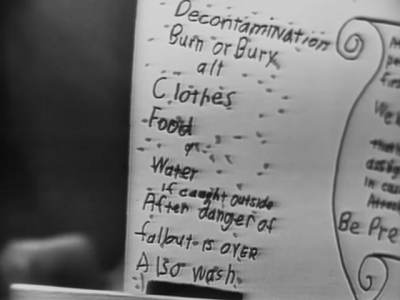 The Atomic Café. |
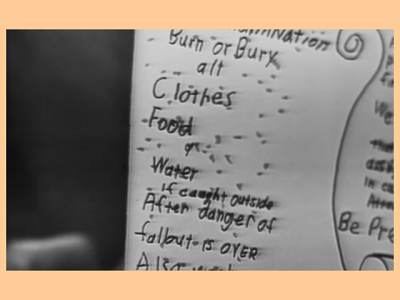 The Atomic Café at The Guild. |
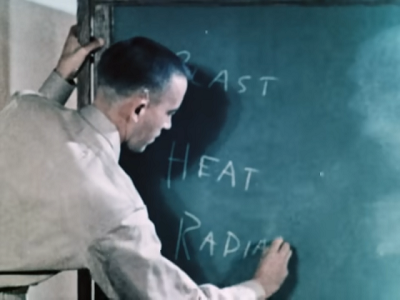 The Atomic Café. |
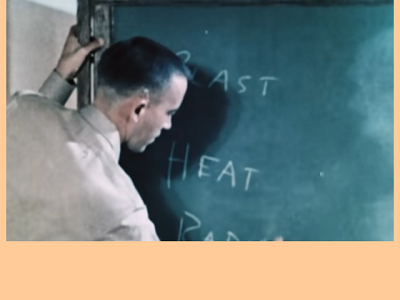 The Atomic Café at The Guild. I distinctly remember that this moment looked like this when shown that afternoon. |
|
The newspaper critic, of course, made not a mention of this, and probably didn’t even notice. | |
Oh, yes!
Saturday, 26 March 1983:
Chilly Scenes of Winter.
I asked to see that, too, because I liked the director.
I kinda sorta liked the movie at the time,
but as I think back on it, I would now detest it with every fiber of my being.
Finally, May 1983:
When the shortened version of
Napoléon vu par Abel Gance from 1927 finally made its Albuquerque première in the spring of 1932,
I asked if I could see that as well.
Sure thing.
I got a pretty cocky idea.
I thought to myself, Heck, I bet they’d let me do it.
I thought I’d rent out a pair of longer lenses.
Now, who would have lenses for rent?
I looked through the yellow pages, saw some place that said it had professional photographic equipment for local rental, and, what the hey, I dialled the number.
A gal answered the phone, and I asked, “I’m wondering, do you rent lenses for 35mm movie projectors?”
The gal screamed, “GAWD!!!!!!” and slammed the phone down on me.
Well, so much for that idea.
Anyway, great movie, but it was all cropped to 1:1.66 senselessness until the final 20 minutes,
when it switched to a reduced anamorphic that was so small we could hardly see it.
(In 2012, at the Oakland Paramount, I saw what was then the fullest known version version, properly projected, accompanied by a full orchestra,
and it was infinitely superior to the shortened version released in the 1980’s. No comparison. Better in every way.
The film made much more sense in that version.)
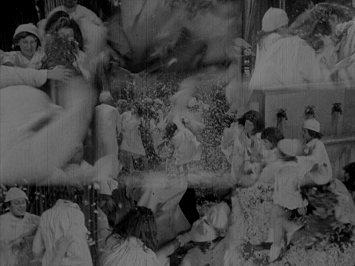 Full .723"×.970" Silent image, designed for a .6796"×.90625" crop, here optically reduced to Academy .630"×.868", designed for a .600"×.825" crop. The image is nine panels. |
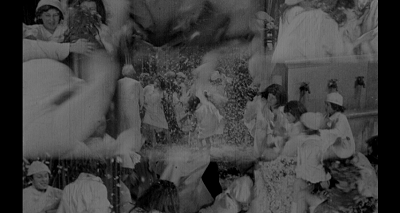 More or less as seen at Don Pancho’s. The image is three panels and another six fragments. |
 The closing triptych, meant to be shown in a large auditorium, on three screens, side by side. |
|
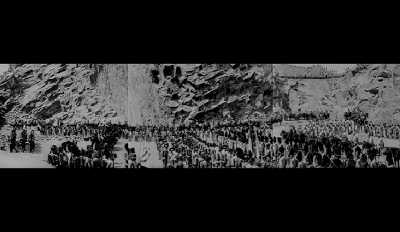 Unfortunately, the screen at Don Pancho’s was only 9'4¾" tall and only about 18 feet wide when the masking was opened to its fullest, and so the climax of the film was quite underwhelming. The apertures, being .775" wide rather than .839", didn’t help. Oh no! I did it again! My memory lied to me! It comes back to me now, so clearly. For the final reel, the projectionist just kept the 1:1.66 (.497"×.825") aperture in the machine. Nonetheless, the sides were lopped off, simply because the masking would not open that wide. |
|
|
The newspaper critic warned readers that the minuscule screen at Donald Pancho’s would diminish the power of this film, which he had seen on a much larger screen at the Lensic in Santa Fé, but he made not a mention of cropping, a topic he probably did not understand or notice. Oh heck, NO critic has ever noticed what the movie was about, anyway. Critics, who know nothing about history, assume that this movie is a pæon to Napoléon. Wrong! The movie is an impression of how people initially viewed Napoléon, and why, but it has numerous harbingers of the horrors to come. The movie was never finished, you know. What was completed was only the first episode of six. | |
Then the most obvious thought occurred to me: “What in the bloody heck am I doing?”
I quit phoning.
I did not want to see anything more.
I did not want to be in those buildings again.
I did not want to see those bizarre people again.
Now that I’ve written this grievance against several of my acquaintances and coworkers,
I realize that they and others could similarly write grievances against me.
There is a difference, though.
However inappropriate my behavior may have been, however childish I may have been,
however annoying or irritating I may have been,
however many dumb mistakes I may have made,
I was never malicious, and I was never hateful.
I am surprised to discover, in my ancient file folder, a list of phone numbers of the staff at Donald Pancho’s.
I am even more surprised to discover that this dates not from the time of my employ, but from a few years later, during the rapprochement.
If I were an investigator, and if I found that someone had such a list under such circumstances, I would conclude, definitively,
that the person had stolen it.
Yet I did not steal it.
If I had it, I had it legitimately.
Somebody on staff openly gave it to me.
Why, I have no memory and I cannot even imagine.
I reproduce it here just in case, five hundred years from now, a historian would find this of use.
Though I retained the prefixes, I blacked out the personal line numbers, even though I’m certain that they’re all disconnected by now.
I never knew or met most of the people named herein.
Oh wait. I vaguely remember.
It was the new assistant manager who handed it to me,
because for some reason he thought I might need to call some of these people.
I never needed to, and I never did.
Here goes:
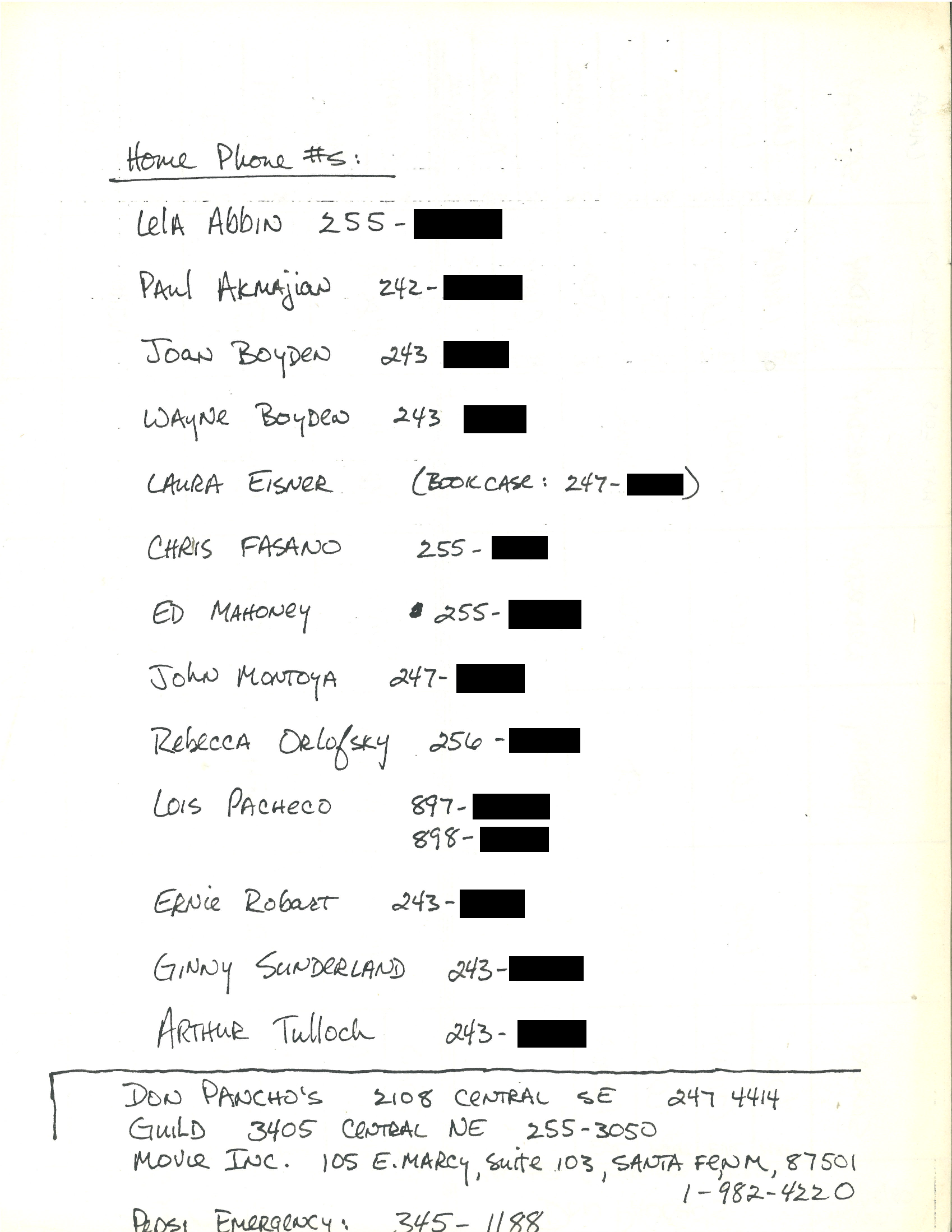
This was written on a piece of scratch paper.
On the reverse side was a remnant of an outdated staff schedule:
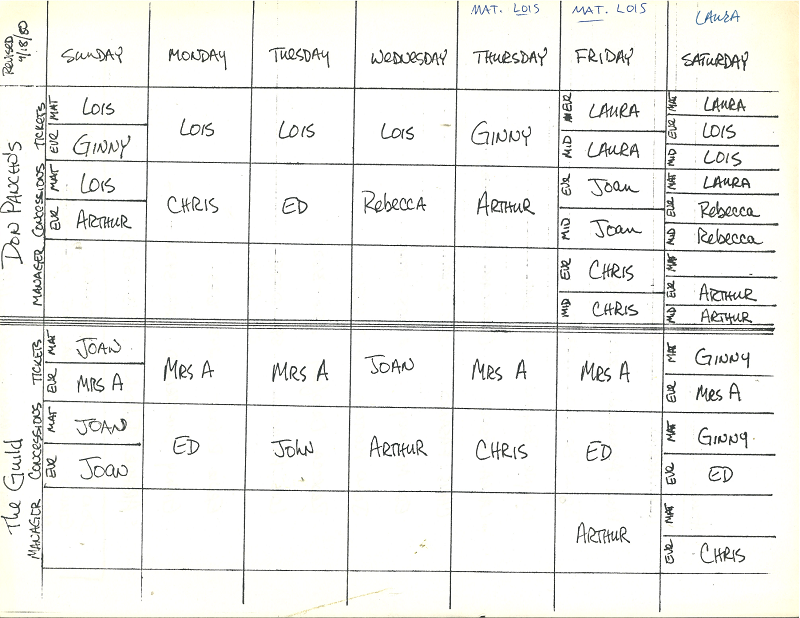
Text: Copyright © 2019–2021, Ranjit Sandhu.
Images: Various copyrights, but reproduction here should qualify as fair use.
If you own any of these images, please contact me.
Images: Various copyrights, but reproduction here should qualify as fair use.
If you own any of these images, please contact me.

